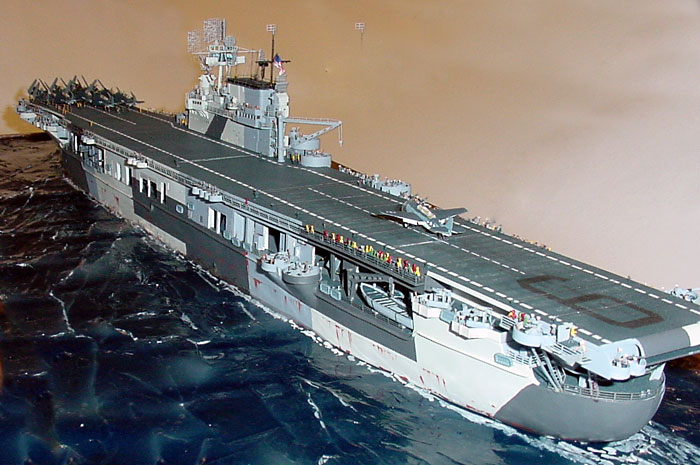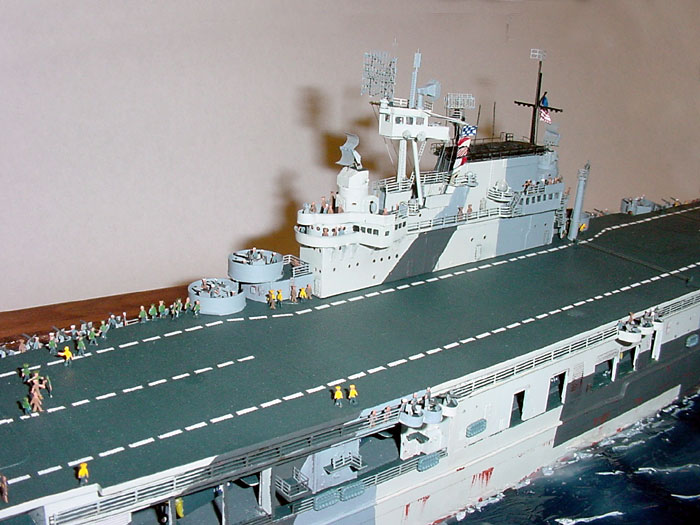|
Trumpeter's 1/350 scale
USS Enterprise CV-6
by
Rick Cotton
|

|
|
USS Enterprise CV-6 |

Trumpeter's
1/350 USS Hornet is available online from Squadron
Easily the most famous of the wartime US
aircraft carriers, Enterprise should have been preserved after the war as
a memorial. The fact that she was not is, in my opinion, a crime, plain
and simple. At least this most heroic and glorious ship, where so many
gave all for their country, can be remembered in the form of a large-scale
model, and that is what I intended to do. I acquired a started Trumpeter
1/350th Hornet and got ready for plastic surgery.
There are four main issues to be addressed
when converting the Hornet kit to a circa-1944 Enterprise:
There is also a late-war radar
fit to install, a measure 33 4AB dazzle paint scheme unique to Big E, and
of course, the late-war aircraft. There are many excellent photos of Big
E, at all stages of her existence at www.cv-6.org. Check it out.
The island is, in my opinion, the most difficult change to make. There is
an expensive resin conversion set available, but I’m way too cheap for
that, and besides, cutting, swearing, and sweating are half the fun,
right? Enterprise was originally launched with a more squared-off,
glassed-in bridge like her sister Yorktown, but a 1943 refit resulted in a
rounded bridge with portholes, much like her later sister, Hornet. She
carried a small gun director in a tub on the front of the bridge, which I
added by cutting one of the leftover tubs from my previous Hornet build
and mating it to the bridge with crazy glue and putty. The foretop on
Enterprise was also glassed in, unlike Hornet, and this had to be
scratchbuilt from sheet plastic. I added clear plastic “glass” to the back
of the windows, along with a few Tom’s Modelworks photoetched sailors and
some ladders and railing. Radar sets from the Tom’s Modelworks Essex set
were added, as well as four photoetched loudspeakers. There is also a
large glassed-in area at the aft port end of the island that was fashioned
in the same way as the foretop. By 1944, Enterprise did not have the lower
platform at the front of the Hornet-style island , so its slot was filled
in, and the bracing under the port bridge structure was added with bits of
sheet styrene.

The torpedo bulge was added by laminating layers of sheet styrene onto the
hull , and then fairing the ends in with putty to get that “pregnant
dolphin” look. I also thinned up the bow somewhat, mostly by much, much
grinding and sanding. I sanded off the molded-on anchor chains and
replaced them with some small chain from my parts box.
The kit’s hangar bulkheads are molded with all doors shut. In an un-air
conditioned steel ship in the Pacific, I can guarantee the doors were open
for ventilation whenever they possibly could be. I cut them open with a
razor saw, and sheeted and detailed the insides, as there is no detail
molded on the inside of the hangar. Sheeting also eliminates the numerous
ejector pin marks on the inside of the bulkheads. I added bits and pieces
of Plastruct, photoetched ladders and railings on interior balconies, and
used some of the brass aircraft detail parts in the Tom’s Modelworks sets
to replicate spare aircraft part stowage. I then added 21 aircraft; TBF’s,
F6F’s and a detachment of F4U-2 night fighters, all in the standard dark
blue/light blue/white scheme, with wings in the folded position. Radomes
were added to the starboard wings of the Corsair night fighters. A
detachment of 3-6 F4U or F6FN night fighters was standard among the big
fleet carriers, and Big E eventually had a completely night-trained air
group embarked. A couple of hundred or so photoetched sailors man the
hangar deck area, in various poses. I used Plastruct beams of various
sizes to add some structural detail to the underside of the flight deck.
Interior bulkheads and underside of the flight deck were sprayed Testors
Flat White. The hangar deck itself was sprayed a slightly lightened mix of
Gunship Gray, heavily weathered and drybrushed. All horizontal decks
outside of the hangar are painted PollyScale Acrylic Weathered Deck Blue.
By 1944, Enterprise was positively infested by new AA guns, with many 40mm
quad and twin mounts replacing her outdated, useless 1.1inch pre-war
mounts, and numerous additional 20mm singles lining her catwalks, each
behind a semi-circular shield of sheet metal armor. I used L’Arsenal’s
40mm twin mounts to update the anti-aircraft suite, and added spare 40mm
quads from my previous CV-10 Yorktown build, along with scratchbuilt tubs
and bracing for all 40mm units. I repositioned most of the 20mm singles,
as they were located differently than Hornet’s 20mm guns.

The fit of the flight deck to the top of the hangar bulkheads is very
good, much better in my opinion than in the later Essex-class kits. There
were some high spots around the elevators at either end that needed
sanding to achieve a flush-deck appearance. I filled and sanded the molded-in
catapults at the forward end of the flight deck, rescribed the deck
planking, and added very thin brass strips to represent the new catapults,
which were “toed-in” towards the bow , and slightly staggered, with the
starboard cat slightly forward of the port. The flight deck was shot with
Pollyscale Acrylic Weathered Deck Blue, the stripes were masked and shot
with Testors flat white, and the deck was then shot with Future to achieve
a gloss finish before the big “6” decals were added. These were inverted
Essex-kit “9”s, graciously provided to me by fellow Hyperscale reader
Wally Bigelow, who also was the source of the Hornet kit and some of the
photoetch. Wally’s a good guy, and a good trader, have no fear dealing
with him. Once the decals were dry, the deck was flat-coated with Testors
Acrylic Clear Flat. I then put thin strips of tape to mask the metallic
tie-down strips, and dry-brushed the wooden portions of the deck in
various shades of flat tan and brown to give the impression of wear on the
blue deck stain. The Toms Modelworks sets supply many photoetch deck
details, including arrestor gear, barriers and such, and they added
greatly to the deck detail , along with metallic gray-sprayed 1 lb. fly
fishing line for wires.
The camouflage scheme was
shot with PollyScale Acrylics, through an ancient Paasche double-action
airbrush. PollyScale is my favorite paint. It lays down flat and smooth,
and water cleanup is a breeze.

The island and crane went on without any incident, finishing up the ship
itself. I decided to pose Enterprise in the midst of recovering her strike
group at the end of the day, with just-recovered aircraft crammed forward
and another coming in at the aft end. The Pacific was replicated with
clear acrylic caulk over a deep-blue painted base.
There she is, the Big E in
all her glory. Long may she and her crew be remembered, both by those who
sailed in her, and those who are still free because of her.
Click on the thumbnails
below to view larger images:
Model, Images and Text Copyright ©
2004 by Rick Cotton
Page Created 16 March, 2004
Last Updated
27 September, 2005
Back to
HyperScale Main Page |
Home
| What's New |
Features |
Gallery |
Reviews |
Reference |
Forum |
Search